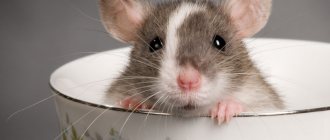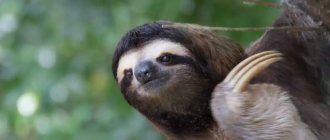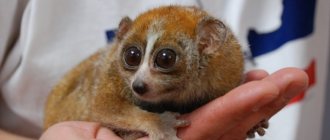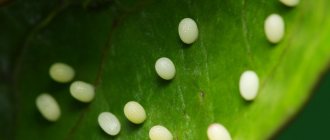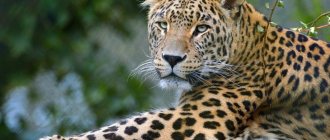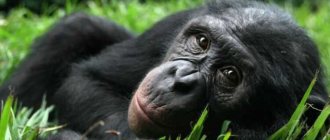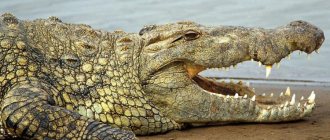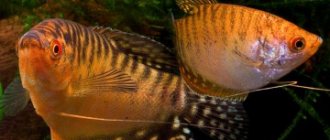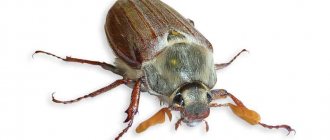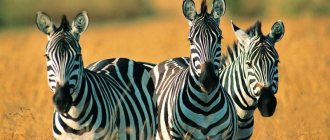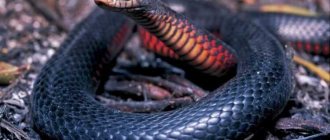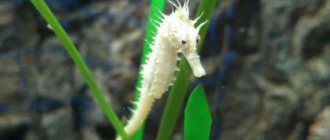Nature has created different types of monkeys, their names are sometimes very unusual and even funny. Take, for example, a species of primate from the family of marmosets called the proboscis monkey, or kahau. The Greek name for proboscis is proboscis, which means trunk. You can immediately guess that monkeys with this name are extremely big-nosed; of course, they are far from having an elephant trunk, but still their nose is large in size. In some representatives of this species it is so large that it interferes with eating during meals, so its owner is forced to maintain his dignity. These amazing animals are on the verge of extinction; they are listed in the Red Book.
Special signs of the proboscis
The common proboscis monkey, or kahau as it is also called, is a very remarkable species of monkey. As you can correctly guess, the appearance of this monkey is distinguished by a large nose, which cannot be found in any other primate.
It is by the nose that you can easily distinguish a female from a male. For girls, it is only slightly elongated, the triangular tip, like a yoke, is turned up, it itself is thin and very neat. The male sex, on the contrary, is famous for its huge, swollen nose, which hangs down like an overgrown cucumber. The male is also distinguished by a peculiar collar in the shoulder area; it, like a cushion, envelops its owner. The proboscis monkey is an animal similar to many males. He has a bloated belly, like a real beer drinker.
Scientific classification
- Kingdom: Animalia (animals)
- Phylum: Chordata
- Class: Mammalia (mammals)
- Order: Primates (primates)
- Family: Cercopithecidae (monkeys)
- Genus: Nasalis (proboscis monkeys)
- Species: Nasalis larvatus (proboscis whale)
This is the only representative of its genus and the largest thin-bodied monkey.
Other names: long-nosed monkey, kahau.
Color and size of the proboscis
The proboscis monkey is a monkey from the monkey family. It stands out among other representatives of this family for its size. This is a medium-sized representative, but, compared to other monkeys, it seems like a giant. The height of this animal is from 55 to 72 centimeters, and it is complemented by a long tail, which can be larger than the body, from 65 to 75 centimeters. Proboscis monkeys weigh 12-25 kilograms, and it is noteworthy that the males, being the same size as the female, weigh almost half as much.
The monkey's head is small and round in shape. All the legs and tail are muscular and tenacious, but since the proboscis monkey practically does not use its tail, it is much less developed than that of other monkeys.
The fur of proboscis cats is short, it fits neatly to the body and does not become ruffled. The back, belly, head and shoulders of this monkey are brownish-red, the collar of the male is whitish, the paws and tail are gray, and there is a white triangle-shaped spot on the lower back. The facial skin of the proboscis monkey is completely devoid of hair and has a brownish-red color.
Natural enemies
There are no large mammalian predators found in Borneo. The main enemies of proboscis snakes are giant combed crocodiles that live in mangrove swamps, sea lagoons, in the lower reaches and deltas of rivers. They lie in wait and attack the monkeys as they cross the river. For this reason, proboscis whales, despite the fact that they are excellent swimmers, try to make the transition in the narrowest part of the water space.
Important! Clouded leopards that live on land do not pose a big threat to proboscis monkeys: the population of these predators is very small, moreover, they prefer to hunt larger prey - goats, deer, wild pigs.
Much more often, kahau become victims of large monitor lizards and pythons, and sea eagles. Poaching also poses a certain danger for them: people pursue proboscis animals because of their tasty meat and beautiful thick fur.
Return to content
Proboscis monkey (monkey): where does it live, how does it move?
This species of animal is found in only one place in the world, the island of Borneo in the Malay Archipelago. The proboscis monkey (monkey) chooses for its habitat coastal areas with mango thickets or wet, dense bushes.
Proboscis monkeys spend most of their time in trees; they rarely go down, only to get water or goodies from the ground. The animal moves in bushes and between trees only along branches, throwing its forelimbs and pulling up its hind limbs. On the shore, in order to cover a short distance, it can walk on two legs, which is characteristic only of anthropoid and highly organized apes.
If water appears on the way to the target, over which it is not possible to jump, proboscis monkeys dive and swim, for this they have membranes on their limbs. The proboscis monkey is the only one of its kind that can swim, including underwater.
Range, habitats
The riverine and coastal plains of Borneo are the only place on Earth where long-nosed monkeys can be found. Their habitats most often choose swampy mangroves, vast expanses of dipterocarp forests with their evergreen giant trees, and hevea plantations adjacent to peat bogs.
This is interesting! Nosed monkeys, when choosing places for their settlements, give preference to the banks of fresh water bodies and rivers. It is believed that this is due to a certain content of minerals and salts in the soil, which is characteristic of this area and is an important formative condition for the feeding system of proboscis monkeys.
In areas located above sea level above 200-350 m, kahau can hardly be seen.
Return to content
Daytime worries
These monkeys feed mainly on fresh leaves and sweet fruits. They choose only unripe fruits and can sometimes feast on insects and flowers. The proboscis whale spends almost its entire day searching for food and absorbing it. The monkey begins its diet from the shore and slowly moves into the thickets, but it does not go far from its habitat.
The proboscis whale cannot be found in areas located more than one kilometer from the water. Towards evening, representatives of the flock, which contains up to thirty individuals, return to their habitat. They live as a family, but never sleep in the same place - they disperse up to 300 meters from each other, preferring to relax alone.
Nutrition
Monkeys eat a variety of foods, but the basis of their diet is:
- fresh tree leaves;
- young shoots;
- flowers;
- unripe and unsweetened fruits;
- various plants (47 species).
Rarely, kohau eat the larvae of tree insects, beetles and caterpillars.
The stomach volume of proboscis monkeys is quite large, so in order to get enough, they have to travel several kilometers a day. They return to their place of settlement only in the evening. Primates begin to look for food near rivers and other bodies of water, gradually moving deeper into the forest.
Kohau do not eat plants that contain natural antibiotics, but they can eat poisonous ones. Their stomach contains bacteria that disinfect the poison.
But the digestive system of these primates has a drawback - they cannot eat sweet fruits, since they begin to ferment quickly in the body. If a proboscis monkey eats such a delicacy, its stomach will swell, which can even cause a painful death.
Lifestyle and behavior
Proboscis animals are called kahau because this is the word they like to shout during morning chants. Males, waking up, begin to scream, and the loudest ones have special authority in the pack.
Each flock of proboscis monkeys has a leader to whom everyone, without exception, obeys. The family lives amicably and practically does not conflict with each other. The growing males are sent to live separately and can only return to their pack when they can compete with all the adult males. Competition sometimes ends with a change of leader, and the former leader is deprived of all privileges and even sometimes offspring, which the new owner can kill. If this happens, then the mother of the murdered baby most often leaves her group.
Lifestyle
Proboscis monkeys live in forests. During the day they are awake, and at night and in the morning the primates rest in the dense crowns of trees near the river, which they have chosen in advance. The highest activity in long-nosed monkeys is observed in the afternoon and evening.
Kahau live in groups of 10-30 individuals. These small alliances can be either harems, where for one male there are up to 10 females with their offspring who have not yet reached puberty, or an all-male company consisting of still single males.
Male proboscis whales grow up and leave their family (at the age of 1-2 years), while females remain in the group in which they were born. In addition, female long-nosed monkeys often practice changing one sexual partner to another. Sometimes, for greater efficiency in obtaining food for themselves or for a good night's sleep, several groups of proboscis monkeys are temporarily combined into one.
Kahau communicate using facial expressions and bizarre sounds: soft muttering, squealing, grumbling or roaring. The nature of monkeys is quite good-natured; they rarely conflict or fight with each other, especially in their own group. Female proboscis monkeys can start a small fight, then the leader of the pack stops it with a loud nasal exclamation.
It happens that the leader changes in a harem group. A younger and stronger male comes and deprives the previous owner of all the privileges. The new leader of the pack may even kill the offspring of the old one. In this case, the mother of the dead babies leaves the group along with the defeated male.
Reproduction and life cycle
Like many animals, the proboscis monkey (monkey) is ready to mate in the spring season. They get into a playful mood, and mostly the females become the initiators of mating. They protrude their lips and curl them into a tube, thereby showing their readiness to bear children.
Cubs are born approximately 170-200 days after mating and have a black muzzle. The noses of both sexes are the same, like those of females. In males, the nose becomes distinctive only at the age of puberty, which occurs at seven years, and in females - at five. Females feed their babies milk until they are seven months old and maintain relationships and help throughout their lives.
How many years do proboscis monkeys live? This question interests many, because this species of monkey is very rare and little is known about it. Monkeys live an average of 30 to 40 years, but proboscis monkeys are not as long-lived. In nature, unless the animal is eaten by a crocodile, which is the main danger of the proboscis monkey, these monkeys live about 23 years.
Eating habits
Proboscis monkeys are seasonal frugivores , eating more than 90 species of plants, mainly young leaves (mature leaves make up only about 3% of the diet). They also eat fruits, seeds, and flowers. Sometimes insects and crabs are added to the menu.
A proboscis monkey weighing about 9 kg consumes 900 grams of wet weight (270 grams of dry weight) of food per day, which is equivalent to 1066 Kcal or 120.68 Kcal/kg body weight.
There are shifts in food consumption depending on the season; from a predominantly fruit diet (January to May) to a predominantly leafy diet (June to December). Sometimes, to speed up digestion, proboscis monkeys chew leftover food from the rumen, the first and largest chamber of the digestive tract.
Proboscis monkeys also consume the bark of certain trees and the nests of arboreal termites. Termites apparently replenish mineral nutrients, absorb toxins, and aid digestion rather than serving as a source of protein.
Communication
The most commonly heard vocalizations are long-drawn cries , with female voices being slightly softer than male voices. To emphasize their position in the group, males make a sound similar to the sound of a trumpet. A roar, low-frequency growl is a characteristic sound of males, expressing readiness for battle.
Photo: hokoonwong
When alarmed, proboscis monkeys emit a high-frequency pitched cry or squeal, the maximum pitch of which is 1.4-6.8 kHz, which is even higher than that of larger primates. The high frequency may be an adaptation to avoid predators and intragroup contact among dense vegetation.
